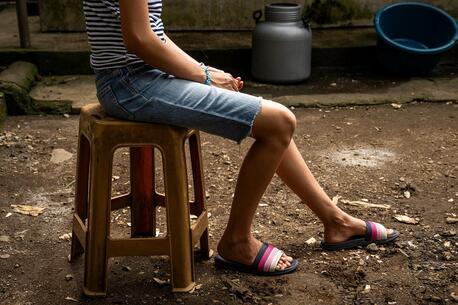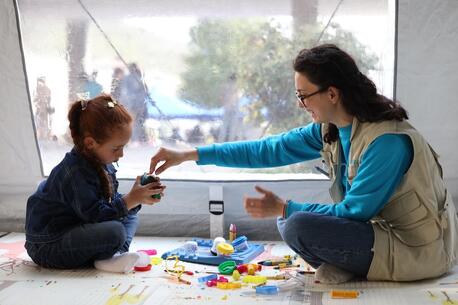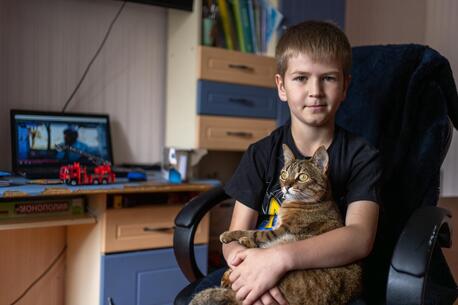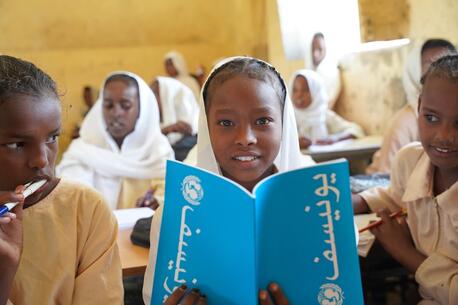
Parenting: How to Support Your Child's Mental Health
Public health authorities have declared a mental health emergency for today's youth. How to recognize when a child is struggling — and how to get help. Some expert tips and resources for parents and caregivers.
A state of emergency in children's mental health
Mental disorders in adults often begin in childhood or adolescence. And many children are struggling right now.
Big issues — the crushing isolation during the COVID-19 pandemic, climate change, wildfires and weather disasters, school shootings — can be a big strain on a child's mental health. Even everyday things like friendships, school and conflicts with parents can be overwhelming, or worse.
The U.S. Centers for Disease Control and Prevention (CDC) reported a steady rise in youth anxiety, depression, substance use and suicide between 2000 and 2020. In 2021, the American Academy of Pediatrics (AAP), the American Academy of Child and Adolescent Psychiatry (AACAP) and the Children’s Hospital Association (CHA) joined together to declare a National State of Emergency in Children’s Mental Health, and the U.S. Surgeon General issued an Advisory highlighting the urgent need to address the youth mental health crisis.
What are parents and caregivers to do?
Supporting a child's mental health starts with an understanding of what "mental health" is.
What is mental health?
Mental health is fundamental to our ability to think, feel, learn, work, create meaningful relationships, navigate life and contribute to society. Mental health means more than just an absence of mental disorders. It is an essential part of overall health and well-being.
Throughout their lives, children and young people experience different levels of positive mental health and well-being. One in 10 of them will also experience a negative mental health condition.
These conditions can be brought on by inherited biological factors like genes and brain chemistry, as well as countless environmental factors like substance abuse, trauma and other life experiences, including race, gender and socioeconomic status. Most likely, experts say, it's a combination.
For example, children and teens in poverty are two to three times more likely to develop a mental health condition than their financially better-off peers.
Between 2016 and 2020, the number of children ages 3-17 years diagnosed with anxiety grew by 29 percent; the number of children diagnosed with depression grew by 27 percent, according to U.S. government data. In 2021, suicide was the second leading cause of death for young people aged 10-14, and the third leading cause for teens aged 15-19, according to the CDC.
Related: mental health conditions explained.
Girls suffer more than boys
Findings from the CDC's Youth Risk Behavior Surveillance surveys show that in school, girls experienced substantially more violence, mental health challenges, suicidal thoughts and behaviors, and substance use than their male peers.
Similarly, kids who identify as lesbian, gay, bisexual, questioning or another non-heterosexual identity continue to experience more violence and mental distress than their heterosexual peers.
Sadly, many kids never get the care they need.
The good news: Parental involvement works
For parents and caregivers, keeping an open dialogue with children throughout their lives can not only help prevent problems but also identify issues early so they can get treatment.
Indeed, staying engaged in your kids' lives has a positive effect. In the survey, students who reported high parental monitoring experienced fewer sexual risk behaviors, less substance use, less violence and better mental health — including fewer suicide attempts.
Supporting your child's mental health starts with a conversation
Start by casually asking how they’re doing. Talk about school, friends, the things they like and dislike doing and what they find difficult.
Use everyday events that cause positive and negative emotions — like winning at sports or scoring a low grade — to check in on how your child feels and to forge a strong bond with them.
- As children get older, and if appropriate to your child’s development, talk about the normal physical and emotional changes they can expect to experience at their age to help them prepare. Perhaps cite a statistic you've read as a jumping-off point to check in on how they’re feeling; if they have any worries or questions, you can talk them through together.
Sustaining support means maintaining an open, trusting and loving environment
Help your child feel comfortable about opening up to you. Your child wants to be liked and accepted by people around them. Being accepted by you is the first step toward building confidence.
Be mindful of your example. Your child looks to you and how you respond to different situations.
Recognize their accomplishments and good behavior.
But if you and your child still don't have good communication, make sure there is someone they can talk to, whether it's a friend, school counselor, religious leader, child psychologist or social worker.
Best practice for good health — both mental and physical
Developing a few good habits will help your child at every age. Parents are advised to support their kids by:
Keeping a consistent sleep schedule so your child gets enough, but not too much, sleep
The American Academy of Sleep Medicine recommends that children aged 6 to 12 sleep 9–12 hours per day; that teenagers aged 13 to 18 sleep8–10 hours a day, and that they put away the stimulating electronic devices and games at least an hour before bedtime.
Making sure kids are eating healthy meals
Healthy eating includes breakfast, with lots of fruit, vegetables and whole grains, and staying hydrated by drinking enough water. A bad diet and insufficient water can make your child tired and depressed, affecting both their physical and mental health.
Making time for kids to be outside for a few minutes of morning sun
This will not only help mood but also vitamin D levels.
Encouraging kids to be physically active and play
Exercise is like a magic pill for good physical and mental health. It not only helps your child fall asleep at night, it improves mood and helps keep them physically fit. It also helps reduce time spent on a computer or phone, playing video games and watching TV.
Preschoolers should have active play throughout the day, adding up to roughly three hours of light to vigorous movement. Kids aged 6 to 17 years old should get 60 minutes or more of moderate to vigorous physical activity each day — and should not be inactive longer than two hours during the day.
Helping them form positive social connections
Group activities such as arts and recreational after-school activities including volunteering in your community help foster good mental health.
Practicing mindfulness
Focusing awareness on the present moment, as well as breathing and meditation programs can help calm children improve their attention span and help them feel more optimistic.
Finding help: Resources for kids and parents
If your child is finding it difficult to cope, don’t be afraid to seek professional help for your child. A good first step is to ask your family doctor or a school counselor for advice. They should be able to assist you in finding treatment, such as time with a child psychologist who can help establish positive mental health habits.
If stress or violence or substance abuse is affecting your child’s life, then it is important they get help as soon as possible so they can start to feel better.
Consider reaching out to one of the following:
- School counselor, psychologist or nurse — they may be able to identify issues and provide advice and short-term counseling to students as well as referrals to other resources such as a licensed clinical social worker for both students and their families
- Doctor or other trusted health care provider — your pediatrician should know what is normal behavior for children at different ages, but they can also give you a referral to a mental health professional like a social worker or child psychologist who specializes in child mental disorders
- State office of mental health or local community mental health office — may offer in-person and Telehealth services as well as family support services
- Support groups — National Alliance on Mental Illness (NAMI) — email helpline@nami.org, text "Friend" to 62640, call 800-950-6264 or consult their excellent Teen and Young Adult Resource Directory; Substance Abuse and Mental Health Services Administration (SAMHSA) — call 800-662-HELP (4357)
- Professional organizations — American Academy of Child and Adolescent Psychiatry, National Academies of Medicine's Supporting Emotional Wellbeing in Children and Youth (offering tools for children, teens and parents), The Trevor Project (providing Crisis Support Services for LGBTQ Young People)
- Hotlines — 988 Suicide & Crisis Lifeline is a national network of of local crisis centers that provides 24/7, free and confidential support for people in distress, as well as prevention and crisis resources for you or your loved ones, and best practices for professionals in the United States; call or text 988 from any U.S. landline or mobile phone
Tips on how parents and caregivers can protect their own mental health
It is common for adults to experience a wide range of emotions — joy, frustration, fatigue, nervousness — at different times. Some form of stress is something every parent and caregiver experiences; don’t be afraid to ask for support, and take time to look after your own needs.
To help manage your own stress, make sure you’ve got good social support around you. Try to have some alone time, so you can have some space for yourself. Remember to invest in enough sleep, healthy food and physical activity.
Related reading
Mental Health Conditions Explained
How to Help Your Anxious Child
How to talk to your children about conflict and war
5 Steps for Helping Someone in Emotional Pain
Protecting Your Child's Mental Health at Every Age



